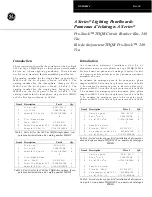
I.B. 3A74792H04
Page 13
Effective 7/97
4-8 ELECTRICAL OPERATION CHECK
After having completed all previous checks and tests,
the circuit breaker is ready to be operated electrically. It
is preferred that this check be made with the circuit
breaker in a TEST position or by using a test cable, if
the circuit breaker is outside the cell structure.
BEFORE INSERTING THE CIRCUIT BREAKER EXAM-
INE THE INSIDE OF THE CELL STRUCTURE FOR
EXCESSIVE DIRT OR ANYTHING THAT MIGHT INTER-
FERE WITH THE CIRCUIT BREAKER MOVEMENT.
EXTREME CAUTION MUST BE EXERCISED TO
INSURE THAT PRIMARY CIRCUITS ARE NOT ENER-
GIZED WHILE CHECKS ARE PERFORMED IN THE
CIRCUIT BREAKER COMPARTMENT. FAILURE TO
DO SO MAY RESULT IN PERSONAL INJURY OR
DEATH.
The circuit breaker is normally tested electrically in its
cell structure in the TEST position. To achieve the TEST
position, the circuit breaker must first be placed in the
cell structure and the secondary contacts engaged. To
complete this testing procedure, the operator should first
be familiar with inserting and removing the circuit break-
er into and from the cell structure.
4-8.1 CIRCUIT BREAKER INSERTION AND
REMOVAL
The circuit breaker is designed to be in one of three dif-
ferent positions within the structure with the door closed,
DISCONNECT, TEST and CONNECTED. While in the
structure, the circuit breaker should never be allowed to
remain at an intermediate position between two of the
three above mentioned designed positions.
Position the circuit breaker squarely in front of the struc-
ture. Integrally mounted wheels facilitate circuit breaker
movement outside of and into the structure. Once the
side mounted circuit breaker alignment rollers are
aligned with structure mounted alignment rails, push the
circuit breaker into the structure as far as it will move.
The levering latch must be fully engaged or the circuit
breaker will not be able to be inserted. This first position
is the DISCONNECT position. Without moving the cir-
cuit breaker, manually engaging the secondary contacts
now makes this the TEST position.
To engage the secondary contacts, grasp the structure
mounted secondary disconnect cage handle located
below the left side of the circuit breaker, and pull it for-
ward as far as possible to make the secondary engage-
ment. As soon as control power is available, the motor
will charge the closing springs.
To move the circuit breaker to the CONNECTED posi-
tion, engage the levering crank with the structure mount-
ed levering shaft and begin turning the handle in a
clockwise direction. Keep in mind that the levering crank
cannot be engaged with the circuit breaker closed.
Structure mounted positive guidance rails interface with
the circuit breaker alignment rollers to insure proper pri-
mary and secondary connections.
The circuit breaker includes all necessary interlocks
that when interfaced with a compatible structure will
render the circuit breaker mechanism mechanically
and electrically trip-free during the levering process
into or out of the structure. For detailed information
pertaining to individual circuit breaker interlocks,
refer to Paragraph 4-9 in this section.
As the handle is turned, the circuit breaker will move
slowly toward the rear of the structure and the integrally
mounted floor movement wheels will be lifted from the
floor of the structure. Eventually, the integrally mounted
wheels are separated from the structure floor by approx-
imately 1/8 inch, and the circuit breaker is suspended in
the structure. This design insures positive primary and
secondary connections, even if the assembly’s mount-
ing conditions are less than ideal.
When the circuit breaker reaches the CONNECTED
position, it will become impossible to continue turning
the levering crank in the clockwise direction. The sec-
ondary contacts will automatically engage in the CON-
NECTED position, if not already engaged manually in
the TEST position.
To remove the circuit breaker from the structure,
reverse the procedure just described by turning the lev-
ering crank in a counterclockwise direction. Keep in
mind that safety interlocks may cause the circuit breaker
to open and/or springs discharge during the removal
procedure. It depends on what condition the circuit
breaker was in as removal began.
!
WARNING
!
CAUTION
NOTICE
Summary of Contents for Cutler-Hammer VCP-W
Page 2: ......







































